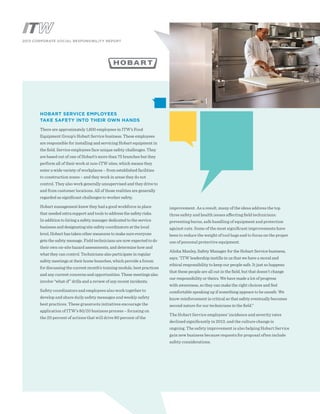
ITW_CSR_HOBART_ONLY_4-2
- 1. HOBART SERVICE EMPLOYEES TAKE SAFETY INTO THEIR OWN HANDS There are approximately 1,600 employees in ITW’s Food Equipment Group’s Hobart Service business. These employees are responsible for installing and servicing Hobart equipment in the field. Service employees face unique safety challenges. They are based out of one of Hobart’s more than 75 branches but they perform all of their work at non-ITW sites, which means they enter a wide variety of workplaces – from established facilities to construction zones – and they work in areas they do not control. They also work generally unsupervised and they drive to and from customer locations. All of those realities are generally regarded as significant challenges to worker safety. Hobart management knew they had a good workforce in place that needed extra support and tools to address the safety risks. In addition to hiring a safety manager dedicated to the service business and designating site safety coordinators at the local level, Hobart has taken other measures to make sure everyone gets the safety message. Field technicians are now expected to do their own on-site hazard assessments, and determine how and what they can control. Technicians also participate in regular safety meetings at their home branches, which provide a forum for discussing the current month’s training module, best practices and any current concerns and opportunities. These meetings also involve “what-if” drills and a review of any recent incidents. Safety coordinators and employees also work together to develop and share daily safety messages and weekly safety best practices. These grassroots initiatives encourage the application of ITW’s 80/20 business process – focusing on the 20 percent of actions that will drive 80 percent of the improvement. As a result, many of the ideas address the top three safety and health issues affecting field technicians: preventing burns, safe handling of equipment and protection against cuts. Some of the most significant improvements have been to reduce the weight of tool bags and to focus on the proper use of personal protective equipment. Alisha Manley, Safety Manager for the Hobart Service business, says, “ITW leadership instills in us that we have a moral and ethical responsibility to keep our people safe. It just so happens that these people are all out in the field, but that doesn’t change our responsibility or theirs. We have made a lot of progress with awareness, so they can make the right choices and feel comfortable speaking up if something appears to be unsafe. We know reinforcement is critical so that safety eventually becomes second nature for our technicians in the field.” The Hobart Service employees’ incidence and severity rates declined significantly in 2013, and the culture change is ongoing. The safety improvement is also helping Hobart Service gain new business because requests for proposal often include safety considerations. 2013 CORPORATE SOCIAL RESPONSIBILITY REPORT